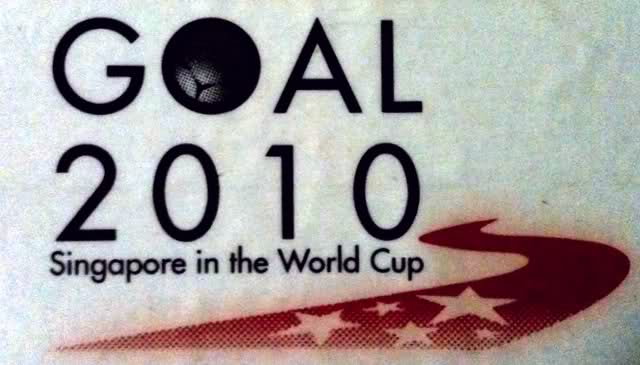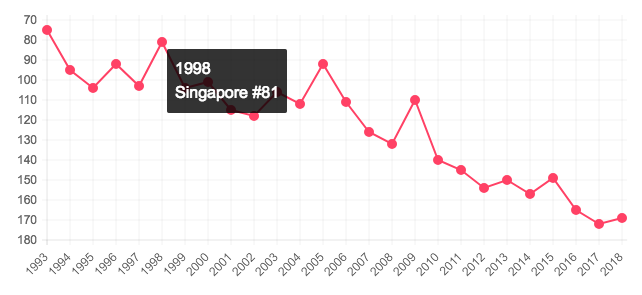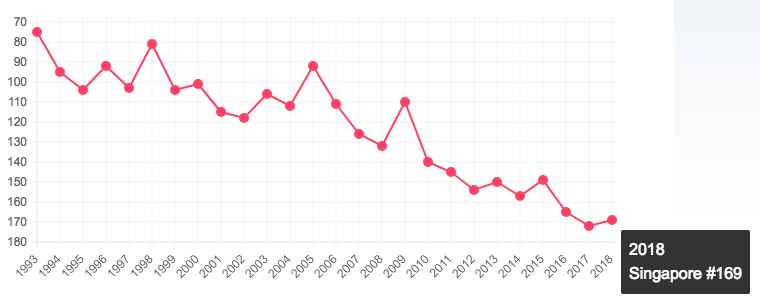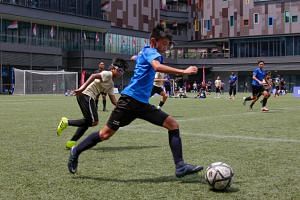Is this just a repeat of the failed 2010 vision?
In 1998, FAS President Marlboro Tan Singapore launched a similar Goal 2010, but failed to qualify for the 2010 World Cup in South Africa.
Now the push is done by another shortie, Edwin Tong.
Sam Leong would be in his 70s by then and be in a wheelchair, tragically paralysed by a PMD.
The Sammyboy discussion on Goal 2010:
https://www.sammyboy.com/threads/mah-bow-tan-goal-2010.37970/
Football: SportSG and FAS unveil blueprint to take local game to the next level

Sport Singapore and the Football Association of Singapore aims to strengthen the local football ecosystem.
PHOTO: ST FILE

David Lee
9 MAR 2021
SINGAPORE - The blueprint to set the Lions on the path to the 2034 Fifa World Cup was unveiled by national sports agency Sport Singapore and the Football Association of Singapore (FAS) on Tuesday (March 9), with its aim to strengthen the local football ecosystem and bring sustainable success.
In a press conference held at the FAS headquarters at Jalan Besar, details of the Unleash the Roar! project was shared with an emphasis on eight pillars:
- Pillar One: Let Them Play
- Pillar Two: Let Them Soar
- Pillar Three: Infrastructure
- Pillar Four: Scholarships
- Pillar Five: National Service
- Pillar Six: Enhanced Technical Capabilities
- Pillar Seven: Science and Technology
- Pillar Eight: Whole-of-Society Partnership
Helmed by SportSG chief Lim Teck Yin and FAS deputy president Bernard Tan, this will be a national project that involves the Ministry of Culture, Community and Youth (MCCY), the Ministry of Education (MOE), SportSG, FAS, the football fraternity, corporate Singapore, and Singaporeans.
While Lim said the cost of the project will be announced at a later date, it is expected to be on top of the $20 million annual budget Singapore football currently receives from the government.
Under this project, the over-arching strategy towards football excellence is to create opportunities for more young Singaporeans to undergo sustained and structured high-quality football training, with a clear talent pathway for those who wish to continue to play and excel as a professional as they grow older.
The project will adopt a phased approach with the first phase taking place in the next two years to put in place the right conditions for footballers to excel covering both "software" and "hardware" aspects. This will lay the foundation for Singapore's football teams across age groups to be more competitive on the regional and international stages.
The brand of football will be a quick and high-tempo one based on a unified curriculum developed by FAS technical director Joseph Palatsides, building on previous syllabi from predecessors Michel Sablon and Slobodan Pavkovic.
With MOE's help, the FAS hopes to increase the participation rate to a minimum of 10 per cent of primary school boys from each cohort (or around 2,000 boys per cohort), providing a steady stream of elite youth players of up to 250 players per cohort for School Football Academies which will be set up at secondary schools. Ideally, they would double their training time to four times a week.
By age 17, they should be ready to break into the Singapore Premier League, and Mindef will provide support under existing schemes to make provisions such as early enlistment and time off so that the athletes can still train for major competitions while fulfilling their National Service obligations.
MCCY and SportSG will also work with FAS to enhance coaching capabilities, supported by sports science and technology, and to enhance the football infrastructure.
Mr Edwin Tong, Minister for Culture, Community and Youth and Second Minister for Law, said in a statement: "For generations, football has been close to the heart of Singaporeans. The sport unites Singaporeans of all ages, races and genders. It is heartening to see multiple stakeholders coming to deliver this vision together.
"This is a collective vision of our people and our next generation of footballers. I am confident that football in Singapore will reach greater heights."
In August 2019, the former FAS vice-president had said it was a "realistic" goal for the Lions to secure a first-ever World Cup qualification in 2034.
While the bulk of that prospective team are in their pre-teens and teens now, Tan said 2034 World Cup qualification is "a good target current participants can aspire to, and is a good checkpoint to see how close we are to our aspirations".
Lim added: "There must be a sense of urgency to get things right and not stay static when we compete. This project is a very important rallying call for all stakeholders to believe that Singapore can do it if we put our hearts and minds to the wheel."
In 1998, FAS President Marlboro Tan Singapore launched a similar Goal 2010, but failed to qualify for the 2010 World Cup in South Africa.
Now the push is done by another shortie, Edwin Tong.
Sam Leong would be in his 70s by then and be in a wheelchair, tragically paralysed by a PMD.
The Sammyboy discussion on Goal 2010:
https://www.sammyboy.com/threads/mah-bow-tan-goal-2010.37970/
Football: SportSG and FAS unveil blueprint to take local game to the next level

Sport Singapore and the Football Association of Singapore aims to strengthen the local football ecosystem.
PHOTO: ST FILE

David Lee
9 MAR 2021
SINGAPORE - The blueprint to set the Lions on the path to the 2034 Fifa World Cup was unveiled by national sports agency Sport Singapore and the Football Association of Singapore (FAS) on Tuesday (March 9), with its aim to strengthen the local football ecosystem and bring sustainable success.
In a press conference held at the FAS headquarters at Jalan Besar, details of the Unleash the Roar! project was shared with an emphasis on eight pillars:
- Pillar One: Let Them Play
- Pillar Two: Let Them Soar
- Pillar Three: Infrastructure
- Pillar Four: Scholarships
- Pillar Five: National Service
- Pillar Six: Enhanced Technical Capabilities
- Pillar Seven: Science and Technology
- Pillar Eight: Whole-of-Society Partnership
Helmed by SportSG chief Lim Teck Yin and FAS deputy president Bernard Tan, this will be a national project that involves the Ministry of Culture, Community and Youth (MCCY), the Ministry of Education (MOE), SportSG, FAS, the football fraternity, corporate Singapore, and Singaporeans.
While Lim said the cost of the project will be announced at a later date, it is expected to be on top of the $20 million annual budget Singapore football currently receives from the government.
Under this project, the over-arching strategy towards football excellence is to create opportunities for more young Singaporeans to undergo sustained and structured high-quality football training, with a clear talent pathway for those who wish to continue to play and excel as a professional as they grow older.
The project will adopt a phased approach with the first phase taking place in the next two years to put in place the right conditions for footballers to excel covering both "software" and "hardware" aspects. This will lay the foundation for Singapore's football teams across age groups to be more competitive on the regional and international stages.
The brand of football will be a quick and high-tempo one based on a unified curriculum developed by FAS technical director Joseph Palatsides, building on previous syllabi from predecessors Michel Sablon and Slobodan Pavkovic.
With MOE's help, the FAS hopes to increase the participation rate to a minimum of 10 per cent of primary school boys from each cohort (or around 2,000 boys per cohort), providing a steady stream of elite youth players of up to 250 players per cohort for School Football Academies which will be set up at secondary schools. Ideally, they would double their training time to four times a week.
By age 17, they should be ready to break into the Singapore Premier League, and Mindef will provide support under existing schemes to make provisions such as early enlistment and time off so that the athletes can still train for major competitions while fulfilling their National Service obligations.
MCCY and SportSG will also work with FAS to enhance coaching capabilities, supported by sports science and technology, and to enhance the football infrastructure.
Mr Edwin Tong, Minister for Culture, Community and Youth and Second Minister for Law, said in a statement: "For generations, football has been close to the heart of Singaporeans. The sport unites Singaporeans of all ages, races and genders. It is heartening to see multiple stakeholders coming to deliver this vision together.
"This is a collective vision of our people and our next generation of footballers. I am confident that football in Singapore will reach greater heights."
In August 2019, the former FAS vice-president had said it was a "realistic" goal for the Lions to secure a first-ever World Cup qualification in 2034.
While the bulk of that prospective team are in their pre-teens and teens now, Tan said 2034 World Cup qualification is "a good target current participants can aspire to, and is a good checkpoint to see how close we are to our aspirations".
Lim added: "There must be a sense of urgency to get things right and not stay static when we compete. This project is a very important rallying call for all stakeholders to believe that Singapore can do it if we put our hearts and minds to the wheel."
Last edited:


 Screenshot via
Screenshot via










